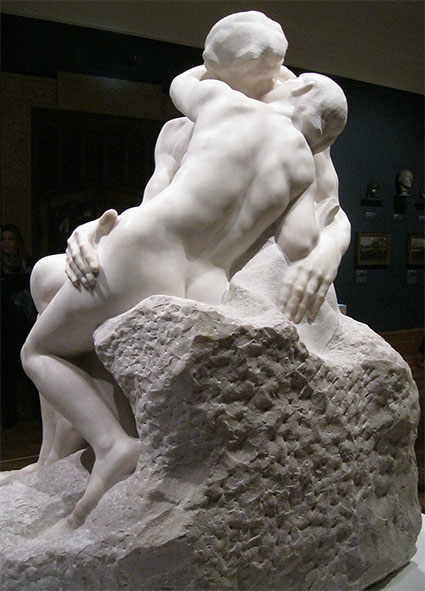- Screen Colours:
- Normal
- Black & Yellow
 The 1900 sculpture by Auguste Rodin, on loan from the Tate, depicts the adulterous lovers Paolo and Francesca, who were mentioned in Dante's Inferno. According to the epic poem, the couple fell in love while reading Lancelot and Guinevere, and were slain by Francesca's furious husband. It was based on a detail from the earlier Gates of Hell. The original sculpture, commissioned by the French Government in 1888, was shown at the Paris Salon the following year.
The 1900 sculpture by Auguste Rodin, on loan from the Tate, depicts the adulterous lovers Paolo and Francesca, who were mentioned in Dante's Inferno. According to the epic poem, the couple fell in love while reading Lancelot and Guinevere, and were slain by Francesca's furious husband. It was based on a detail from the earlier Gates of Hell. The original sculpture, commissioned by the French Government in 1888, was shown at the Paris Salon the following year.
In 1900, Rodin made a copy for Edward Perry Warren, an eccentric American collector, who lived in Lewes in Sussex with his collection of Greek antiquities and his lover John Marshall. Warren offered half the original amount, but Rodin would not lower the price. The contract for the commission included that ‘the genitals of the man must be complete.’
When the sculpture arrived in Lewes in 1904, Warren placed it in the stables at the back of his home, where it remained for a decade. It is not known whether this location was chosen owing to the great size of the sculpture or because it did not fulfil Warren's expectations. In 1914 the sculpture was loaned to the Lewes town council and put on public display in the Town Hall. A number of puritanical local residents objected to the erotic nature of the sculpture. They were particularly concerned that it might encourage the ardour of the large number of soldiers who were billeted in the town at that time, and successfully campaigned to have the sculpture draped and screened from public view.
Eventually, in 1955, the Tate bought the sculpture for the nation at a cost of £7,500. In 1999 between 5 June and 30 October, The Kiss returned briefly to Lewes as part of an exhibition of Rodin's works. Its regular home is now the Tate Modern.
Several other Rodin sculptures inspired by movement and dance are on display with The Kiss. The exhibition continues at the Wolsey Gallery in Christchurch Mansion until 28 April 2019. It features an impressive selection of sculptures, reliefs and drawings with a Suffolk connection. John Constable’s figure drawings are a revelation.
R.G.
On show in the Wolsey Gallery: the monumental figures (look at the size of his hands) emerge from the rough-hewn marble.